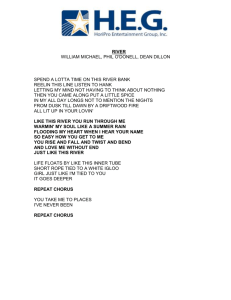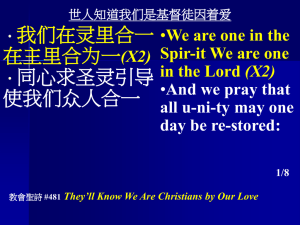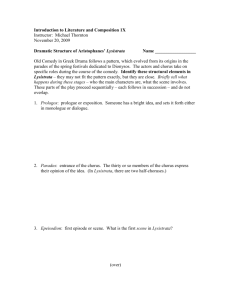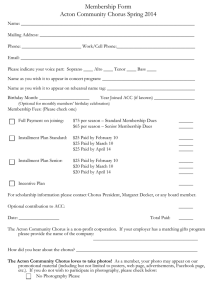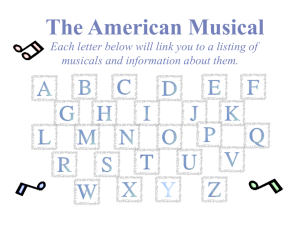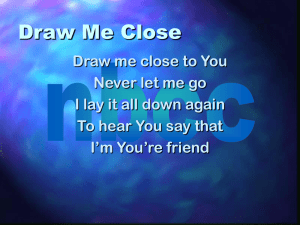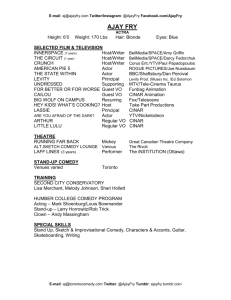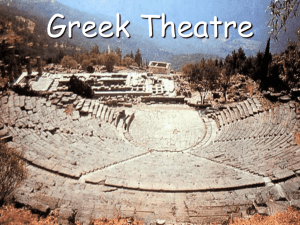History of Theatre video answer key
advertisement
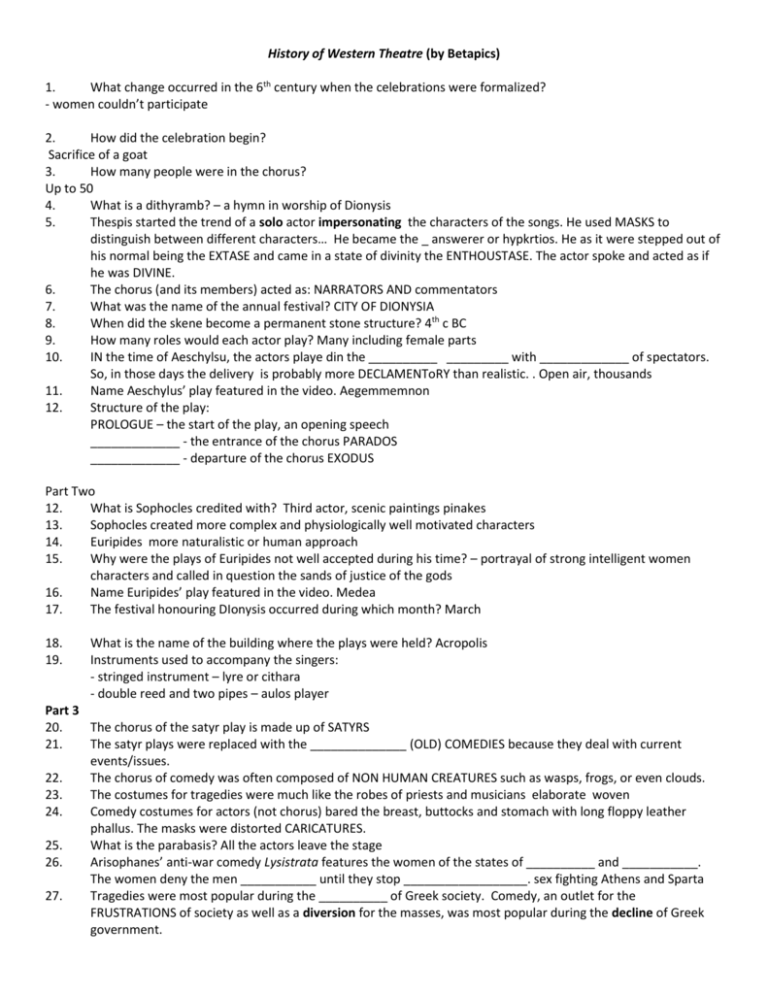
History of Western Theatre (by Betapics) 1. What change occurred in the 6th century when the celebrations were formalized? - women couldn’t participate 2. How did the celebration begin? Sacrifice of a goat 3. How many people were in the chorus? Up to 50 4. What is a dithyramb? – a hymn in worship of Dionysis 5. Thespis started the trend of a solo actor impersonating the characters of the songs. He used MASKS to distinguish between different characters… He became the _ answerer or hypkrtios. He as it were stepped out of his normal being the EXTASE and came in a state of divinity the ENTHOUSTASE. The actor spoke and acted as if he was DIVINE. 6. The chorus (and its members) acted as: NARRATORS AND commentators 7. What was the name of the annual festival? CITY OF DIONYSIA 8. When did the skene become a permanent stone structure? 4th c BC 9. How many roles would each actor play? Many including female parts 10. IN the time of Aeschylsu, the actors playe din the __________ _________ with _____________ of spectators. So, in those days the delivery is probably more DECLAMENToRY than realistic. . Open air, thousands 11. Name Aeschylus’ play featured in the video. Aegemmemnon 12. Structure of the play: PROLOGUE – the start of the play, an opening speech _____________ - the entrance of the chorus PARADOS _____________ - departure of the chorus EXODUS Part Two 12. What is Sophocles credited with? Third actor, scenic paintings pinakes 13. Sophocles created more complex and physiologically well motivated characters 14. Euripides more naturalistic or human approach 15. Why were the plays of Euripides not well accepted during his time? – portrayal of strong intelligent women characters and called in question the sands of justice of the gods 16. Name Euripides’ play featured in the video. Medea 17. The festival honouring DIonysis occurred during which month? March 18. 19. What is the name of the building where the plays were held? Acropolis Instruments used to accompany the singers: - stringed instrument – lyre or cithara - double reed and two pipes – aulos player Part 3 20. The chorus of the satyr play is made up of SATYRS 21. The satyr plays were replaced with the ______________ (OLD) COMEDIES because they deal with current events/issues. 22. The chorus of comedy was often composed of NON HUMAN CREATURES such as wasps, frogs, or even clouds. 23. The costumes for tragedies were much like the robes of priests and musicians elaborate woven 24. Comedy costumes for actors (not chorus) bared the breast, buttocks and stomach with long floppy leather phallus. The masks were distorted CARICATURES. 25. What is the parabasis? All the actors leave the stage 26. Arisophanes’ anti-war comedy Lysistrata features the women of the states of __________ and ___________. The women deny the men ___________ until they stop __________________. sex fighting Athens and Sparta 27. Tragedies were most popular during the __________ of Greek society. Comedy, an outlet for the FRUSTRATIONS of society as well as a diversion for the masses, was most popular during the decline of Greek government. 28. New comedy began after Athens lost wars against the Spartans and the Macedonians. Politician issues were ignored. First time love became a principle element in drama seldom an honest love, role of chorus often diminished. 29. Costume based on ordinary life, more realistic masks 30. Different everyday affairs not events of the past 31. Menander – happy ending, disapproval of parent of marriage of child Contemporary dialect, 32. Comedy became less popular and Drama contests stopped in first century AD Part 4 33. When Alexander the Great took over the Greek city states, plays were no longer performed only at Dionysian festivals. Many new theatres were built. 34. The most important Hellenistic innovation was the Logeion, the _____________ __________. the raised stage. 35. Openings or doors known as THYROMATA might have been used as a miniature proscenium arch. 36. When did mainland Greece become a Roman province? 146 BC 37. How did the stage change after the Romans took over? Lowered stage larger playing areas and heightened skene, orchestra surround with stone barricade to protect spectators, skene adorned with sculptures, Only temporary wooden theatres were built. 38. Theatre was deemed a threat to Roman morality. IN Greece theatre was a symbol of DEMOCRACY but the Roman Republic was ARISTOCRATIC. 39. VELUM A wooden or linen canvas covering to protect spectators from sun and rain. 40. Greek theatres were not ENCLOSED so those in the higher seats could see the countryside. 41. Changes in theatres from Classical Greece through Hellenistic Period to Roman times Orchestra goes from _______ circle to 2/3 circle to __________ - circle. (full, semi) Stages – from proskene to logeion to _________________ pulpitum

